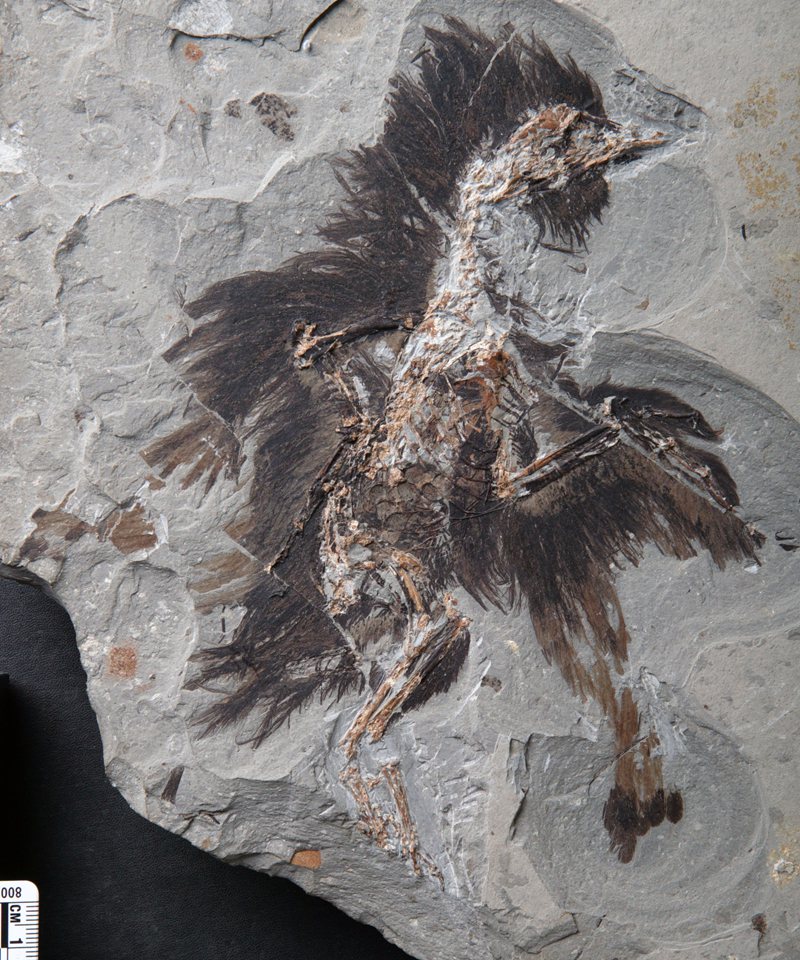November 22, 2016, By Ben Guarino, The washington Post

Fossils of ancient bird, Eoconfuciusornis, revealed microscopic evidence of pigment within its feathers, which were preserved for 130 million years.
An international team of U.S. and Chinese scientists analyzed the color of the bird, the oldest known avian after the proto-bird Archaeopteryx, by first identifying a protein from its fossilized feathers that enables modern-day birds to fly.
The protein, beta-keratin, is the stuff of nails, feathers, scales and beaks. Evolutionary history and modern genetic evidence indicates that feather keratins evolved from reptilian scale keratins. (Beta-keratin is not to be confused with beta-carotene, the orange pigment found in carrots and other plants.) The keratin proteins are arranged like building blocks to give a particular biological structure its function, akin to the way brick can form a walkway or a chimney.
Scientists studied Eoconfuciusornis beta-keratin buried deep within the animal’s fossilized feathers. They probed the keratin structures to find small, dark grains called melanosomes. These are the little specks within animal cells that give skin and other tissues its color. Although melanosomes had been discovered in fossilized creatures before, it was previously too difficult to tell if the dark granules belonged to the animal itself or ancient microorganisms preserved alongside it.
The trick was to pick out the bird melanosomes embedded within the keratin. “If we couldn’t find the keratin, then those structures could as easily be microbes, or a mix of microbes and melanosomes — in either case, predictions of dinosaur shading would not be accurate,” said study author and North Carolina State University biologist Mary Schweitzer in a news release.
In a new study published in the Proceedings of the National Academy of Sciences, the researchers used an analytical technique not traditionally applied to 130-million-year-old animals. Chinese Academy of Sciences paleontologist Pan Yanhong told the South China Morning Post that, “We must remove many unwanted materials to reveal the keratin proteins, and for the job I borrowed some techniques used in the study of ancient human DNA.” The price of the technique was that parts of the fossil, each sliver about the size of a rice grain, were destroyed in the process.
Eoconfuciusornis — the “early Confucius bird” or “the dawn of the Confucius bird” — was first discovered in
2008, and is thought to have been the size of a crow. It was the first animal known to have a
toothless, horned bill like a bird. The specimen used in the current study was found in Hebei, China, where a lake once existed during the beginning of the Cretaceous period. (An amateur paleontologist previously unearthed the slightly younger Confucius bird,
Confuciusornis, when he purchased a specimen at a
flea market in Jinzhou in 1993.)
As University of Bristol paleontologist Mike Benton told National Geographic at the time of the bird’s discovery, there was a question of just what colors its plumage bore when it was alive. The early Confucius bird could have been brown and black. Or, Benton said, “these might alternatively have been the bright reds, blues, and yellows of modern birds.”
The melanosomes examined with the new technique lent support to the idea that the early Confucius bird’s body was brownish or dark in color. What’s more, the study hinted at future discoveries embedded within additional ancient skins and feathers. As Pan said to the South China Morning Post, “We can use the same technology to study other animals, such as dinosaurs.”
From: https://www.washingtonpost.com/news/morning-mix/wp/2016/11/22/this-ancient-chinese-bird-kept-its-feathers-and-colors-for-130-million-years/#comments
